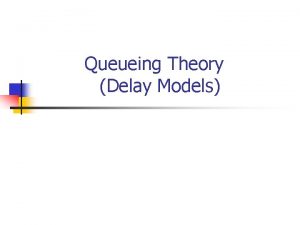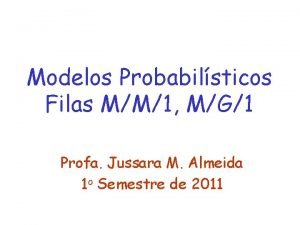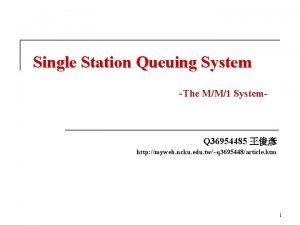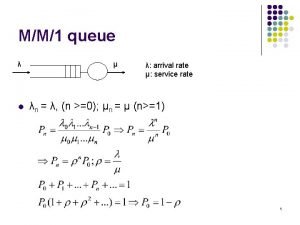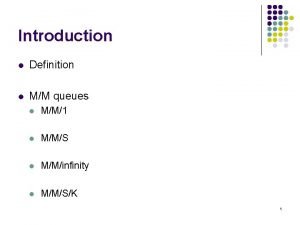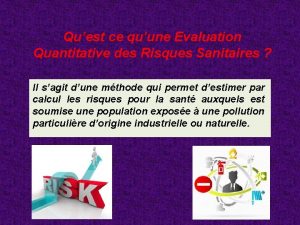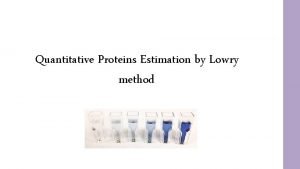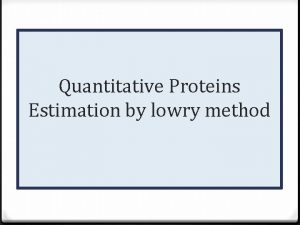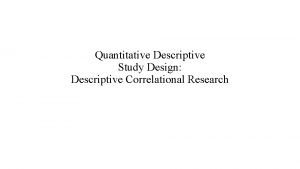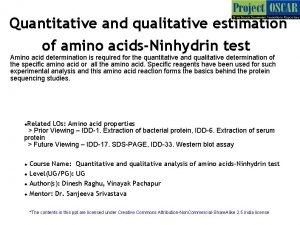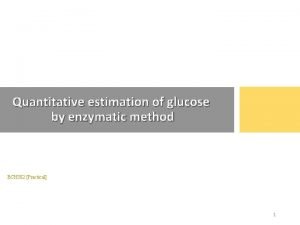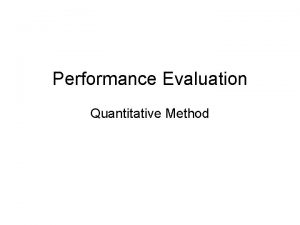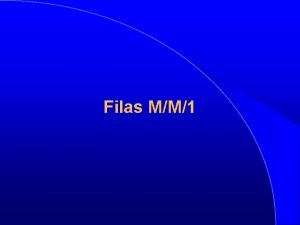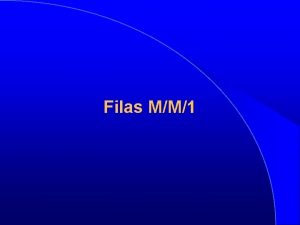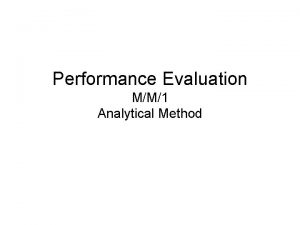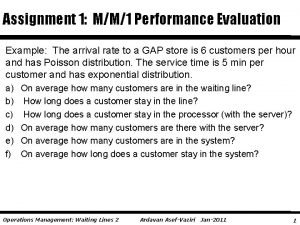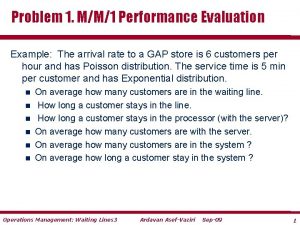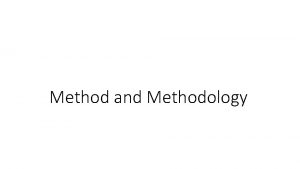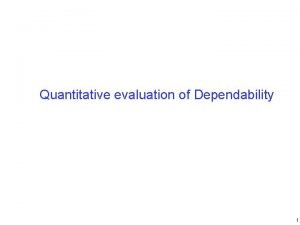Performance Evaluation MM1 Quantitative Method Performance Evaluation Quantitative
















- Slides: 16

Performance Evaluation M/M/1 Quantitative Method

Performance Evaluation – Quantitative Method M/M/1 Abstract System/ Black Box SYSTEM Resource X N Arrivals Service Time Completions (A) (S) (C) Busy (B) – Length of time that the resource was observed to be in use Service Time B S= C Arrival Rate A = l T R Time (T) – Fraction of time the system is observed Throughput C = X T Utilization B = U T

Performance Evaluation – Quantitative Approach A- Arrivals C- Completions T- Time the system is observed B- Busy; fraction of time system is being used’ S- Avg. service time S= X- Throughput C = X T λ- arrival rate U- Utilization B C A l= T B C = * U S X C T U= B T

System Arrival and Completions 15 14 13 Customers in system 12 11 10 Jobs 9 8 7 Arrivals 6 Completion 5 4 3 2 1 Time 0 0 2 Accumulated Time in System 4 Avg. Residence Time 6 Little’s Law

Little’s Law n(t) Number of customers in the black box k N t 0 rk Total time that there are k customers in the black box

Performance Evaluation – Quantitative Approach W- Accumulated time in system N- Average number of requests in system Z- Avg. think time R- Response Time

Performance Evaluation – Quantitative Approach Utilization Law: Uk = X k S k Little’s Law: N = XR The Response Time Law: R = N/X – Z The Forced Flow Law: Xk = V k. X

Performance Evaluation – Example 1 An interactive system with 25 active terminals shows an average think time of 18 seconds. On average, each interaction causes 20 disk accesses. If the service time access per disk access is 25 ms. , and the disk is 30% busy. What is the average system response time in seconds? 25 terminals (N = 25) 18 sec average think time (Z = 18) 20 visits to specific disk per interaction (Vd = 20) 30% utilization of disk (Ud =. 30) 25 millisecond – avg. service requirement per visit to disk (Sd =. 025 sec) Disk Throughput: Xd = Ud / Sd =. 3/. 025 = 12 req/sec System throughput: X = Xd / Vd = 12 / 20 = 0. 6 interactions/ sec Response time: R = (N / X) – Z = ( 25 /. 6 ) – 18 = 23. 7 sec

Performance Evaluation – Example 2 During a measurement interval of 1200 sec. , an e-commerce site was monitored, and during this period, 4, 800 transactions were executed. We know that a transaction visits the web server 5. 2 times and the database server 3. 8 times. The database service time is 59 msec. and the Web service time is 35 msec. What is the average throughput of the database server and of the Web server? Calculate the Utilization of the two resources. T = 1200 sec C = 4800 completions Vweb = 5. 2 Vdb = 3. 8 Sweb = 35 msec Sdb = 59 msec X = 4800/1200 = 4 request/sec Xweb = Vweb * X = 5. 2 * 4 = 20. 8 io/sec Uweb = Sweb * Xweb =. 035 sec * 20. 8 io/sec = 0. 728 ( 72. 8 %) Xdb = Vdb * X = 3. 8 * 4 = 15. 2 io/sec Udb = Sdb * Xdb =. 059 sec * 15. 2 io/sec = 0. 896 ( 89 %)

Performance Evaluation M/M/1 Analytical Method

Performance Evaluation – Analytical Method (M/M/1) Birth-Death Process (M/M/1) Arrivals (A) Completions (C) N = Avg # of IORB in the system The arrival of a new IORB is called a birth IORB I/O IORB Time it takes to give service (S) # of IORBs in the system T A C S Time we observe the system # of Arrival # of Completions Service Time Arrival Rate K K+1 The completion of an IORB is called a death K-1 K IORB Completion Rate * All these when system is in steady state

Performance Evaluation – Analytical Method (M/M/1) Flow in = flow out 0 1 2 3 4 … k-1 Avg. # of IORB in the system Fraction of time server has k IORBs k The flow across the line to the right is the probability of being in state (k-1) times the rate at which the system transitions from state (k-1) to k The flow across the line to the left is the probability of being in state k times the avg. service rate N 0 t rk

Performance Evaluation – Analytical Method (M/M/1) Flow out Flow in Geometric series Utilization Law

Performance Evaluation – Analytical Method (M/M/1) Avg. # of IORB’s in the system Geometric series

Performance Evaluation – Analytical Method M/M/1 Response Time Little’s Law

Performance Evaluation – Analytical Method M/M/1 Average waiting Time in queue use Average # of IORBs in queue Little’s Law
 Queuing theory examples
Queuing theory examples M/m/1 formulas
M/m/1 formulas Mm1 system
Mm1 system Mm1 formulas
Mm1 formulas Mm1 meaning
Mm1 meaning évaluation quantitative des risques
évaluation quantitative des risques Purpose of symposium
Purpose of symposium Sampling methods in qualitative and quantitative research
Sampling methods in qualitative and quantitative research Descriptive research design
Descriptive research design Lowry method
Lowry method Protein estimation by lowry method
Protein estimation by lowry method Quantitative descriptive correlational research design
Quantitative descriptive correlational research design What are the two kinds of quantitative research
What are the two kinds of quantitative research Quantitative estimation of amino acids by ninhydrin method
Quantitative estimation of amino acids by ninhydrin method Enzymatic methods for glucose determination
Enzymatic methods for glucose determination Computer architecture performance evaluation methods
Computer architecture performance evaluation methods Portfolio performance evaluation problems
Portfolio performance evaluation problems
